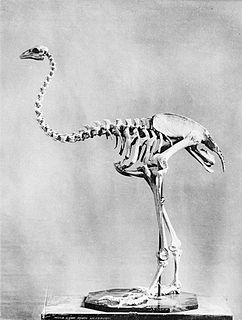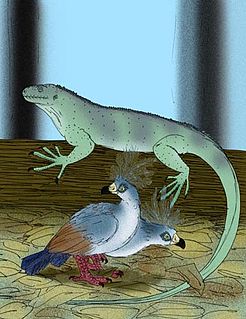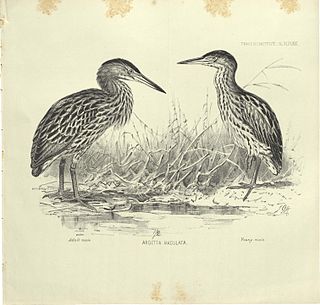
The stiff-tailed ducks, Oxyura, are part of the Oxyurini tribe of ducks. The genus name is derived from Ancient Greek oxus, "sharp", and oura, "tail".

The New Zealand merganser, Auckland merganser or Auckland Islands merganser was a typical merganser which is now extinct.

The upland moa was a species of moa bird endemic to New Zealand. It was a member of the ratite family, a type of flightless bird with no keel on the sternum. It was the last moa species to become extinct, vanishing around 1500 CE and was predominantly found in alpine and sub-alpine environments.
The New Zealand raven was native to the North Island and South Island of New Zealand but has been extinct since the 16th century. There were two subspecies: the North Island raven and the South Island raven. Another closely related species, the Chatham raven, occurred on the Chatham Islands.

The Viti Levu giant pigeon or Fiji giant ground pigeon is an extinct flightless pigeon of Viti Levu, the largest island in Fiji. It was only slightly smaller than the dodo and Rodrigues solitaire and is the first giant, flightless pigeon to be discovered on a Pacific island.
The long-billed wren was a species of New Zealand wren endemic to the South Island of New Zealand. It was the only species in the genus Dendroscansor. The long-billed wren was a small bird with stout legs and tiny wings. Its reduced sternum suggests that it had weak flight muscles and was probably flightless, like the recently extinct Lyall's wren. Its weight is estimated at 30 g, which makes it heavier than any surviving New Zealand wren, but lighter than the also-extinct stout-legged wren. The bill of this species was both long and curved, unlike that of all other acanthisittid wrens.
Finsch's duck was a large terrestrial species of duck formerly endemic to New Zealand. The species was possibly once the most common duck in New Zealand, a supposition based on the frequency of its fossils in bone deposits. The species was originally considered to be in its own genus, Euryanas, but is now known to be closely related to the maned duck and recently derived from that species.

The New Zealand bittern is an extinct and enigmatic species of heron in the family Ardeidae. It was endemic to New Zealand and was last recorded alive in the 1890s.
Trevor Henry Worthy is an Australia-based paleozoologist from New Zealand known for his research on moa and other extinct vertebrates.
Lake Poukawa is a small shallow hardwater lake in the Hawke's Bay Region, North Island, New Zealand. It is located about 20 km south-west of Hastings, New Zealand, close to the settlement of Te Hauke. It is the largest lake lying within a peatland in the active tectonic Poukawa depression, between the Raukawa Range and Kaokaoroa Range of central Hawke's Bay. Its maximal depth is less than one metre and its diameter is ca. 1.5 km. It was deeper in the past but it became artificially drained after the 1931 Hawke's Bay earthquake. Lake Poukawa became a well-known paleontological site in 1956 when paleontologist Russell Price began with his excavations in the lacustrine deposits. Lake Poukawa had a species rich Pleistocene/Holocene waterfowl fauna. More than 13,400 anatid bones were unearthed at this site since 1956. Extinct birds found at Lake Poukawa include Biziura delautouri, Oxyura vantetsi, Mergus australis, Chenonetta finschi, Pachyornis geranoides, Ixobrychus novaezelandiae, Gallinula hodgenorum, Fulica prisca, Malacorhynchus scarletti, and Cnemiornis gracilis.
Scarlett's duck is an extinct duck species from New Zealand which was closely related to the Australian pink-eared duck. The scientific name commemorates the late New Zealand ornithologist and palaeontologist Ron Scarlett who discovered the holotype in 1941. However, previously undescribed bones of the species found in 1903 were rediscovered in the Otago Museum in 1998. At least 32 fossil remains from deposits in Pyramid Valley, at Ngapara in the South Island, and at Lake Poukawa in the North Island are in museum collections.
Tribonyx hodgenorum, also known as Hodgens's waterhen or Hodgen's rail, is an extinct rail species from New Zealand. Its name commemorates the Hodgen brothers who were owners of the Pyramid Valley swamp where the holotype was discovered. It reached a weight of 280 g and its wings were so reduced that it was unable to fly. It occupied a wide range of habitats, including open forest and grassland along riverbanks.
The stout-legged wren or Yaldwin's wren is an extinct species of New Zealand wren, a family of small birds endemic to New Zealand.

The North Island giant moa is one of two extinct moa in the genus Dinornis.
Scarlett's shearwater is an extinct species of seabird in the petrel family Procellariidae. Its common name commemorates New Zealand palaeontologist Ron Scarlett, who recognised the bird's subfossil remains represented a distinct species.
The New Zealand musk duck, also known as de Lautour's duck, is an extinct stiff-tailed duck native to New Zealand. It is only known from subfossil bones. Its closest relative was the living Australian musk duck Biziura lobata, with which it has sometimes been combined.
The Chatham duck or Chatham Island duck is an extinct species of duck, formerly placed in a monotypic genus Pachyanas, which once lived in New Zealand's Chatham Islands in the south-west Pacific Ocean. It was described by Walter Oliver from bird bones in the collection of the Canterbury Museum in 1955 in the second edition of his work New Zealand Birds. Recently, analysis of mitochondrial DNA extracted from subfossil remains showed that the Chatham duck was not, in fact, closely related to shelducks but instead belongs in the genus Anas: the dabbling ducks. Its closest living relatives appear to be the Auckland teal, Campbell teal and the brown teal from New Zealand. Some authors have suggested that the Chatham duck was flightless; however, comparison of Chatham duck wing bones with those from living ducks indicates no disproportional reduction in wing length. The Chatham duck likely became extinct in about the 16th century because of hunting by humans.
The Viti Levu scrubfowl, also known as the Fiji scrubfowl or lost megapode, is an extinct megapode that was endemic to Fiji. The epithet amissus, from Latin "lost", refers to its extinction. Subfossil remains were collected from the Udit cave at Wainibuku on the island of Viti Levu in October 1998 by Trevor Worthy, G. Udy and S. Mataraba, and described by Worthy in 2000. The holotype is held by the Museum of New Zealand.
The noble megapode, also known as the deep-billed megapode, is an extinct, flightless, giant stem-galliform bird that was endemic to Fiji. Originally thought to be a megapode, more recent morphological studies indicate a close relationship with Sylviornis, in a clade outside of the Galliformes crown group. It is likely that it became extinct through overhunting shortly after the colonisation of the Fiji Islands by humans.
Pelecanoides miokuaka is an extinct species of diving petrel of New Zealand. Described in 2007, it is known only from a single humerus bone that was discovered from early Miocene sediments of the Manuherikia Group.





